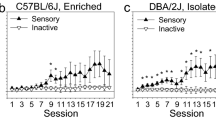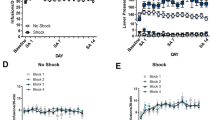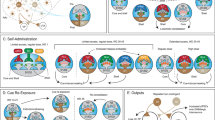Abstract
Previous studies have reported intravenous cocaine self-administration behavior in several strains of mice with the exception of BALB/cByJ, a strain considered a mouse model of high emotional reactivity. The present experiments further investigated acquisition of self-administration in BALB/cByJ mice using a low dose and a habituation session. Following evidence of an initial drug-seeking behavior, we observed a progressive decline of intravenous self-administration. Pretreatment with diazepam (0.5 mg/kg, IP), reinstated cocaine-maintained responding. To test the hypothesis that injections directly into a reward-relevant brain region might support consistent cocaine-seeking behavior, BALB/cByJ mice implanted in the nucleus accumbens (NAc) or the caudate-putamen nucleus (CPu) were trained to discriminate between the arm enabling a microinjection of cocaine (30 pmol/50 nl or 150 pmol/50 nl) and the neutral arm of a Y-maze. Only NAc subjects exhibited a spatial discrimination toward the cocaine-reinforced arm and the D2 antagonist, sulpiride (50 mg/kg, IP) eliminated intra-NAc cocaine self-administration. However, after several days of cocaine self-injection, animals developed an approach/avoidance-like behavior between the start box and the reinforced arm. This behavior was suppressed by systemic diazepam (1 mg/kg, IP) pretreatment. We conclude that: (1) medio-ventral NAc is involved both in the rewarding (via a D2 dopaminergic mechanism) and aversive effects of cocaine in mice; and (2) anxiolytic pretreatment (diazepam) indirectly enhanced the reinforcing properties of cocaine in BALB/cByJ, suggesting that emotionality can act as a protective mechanism against stimulant abuse.
Similar content being viewed by others
Log in or create a free account to read this content
Gain free access to this article, as well as selected content from this journal and more on nature.com
or
References
Alheid GF, Heimer L . (1988): New perspectives in basal forebrain organization of special relevance for neuropsychiatric disorders: The striatopallidal, amygdaloid, and corticopetal components of substantia innominata. Neurosci 27: 1–39
Anthony JC, Tien AY, Petronis KR . (1989): Epidemiologic evidence on cocaine use and panic attacks. Am J Epidemiol 129: 543–549
Aronson TA, Craig TJ . (1986): Cocaine precipitation of panic disorder. Am J Psychiat 143: 643–645
Bardo MT . (1998): Neuropharmacological mechanisms of drug reward: Beyond dopamine in the nucleus accumbens. Crit Rev Neurobiol 12: 37–67
Bardo MT, Donohew RL, Harrington NG . (1996): Psychobiology of novelty-seeking and drug seeking behavior. Behav Brain Res 77: 23–43
Belzung C, Berton F . (1997): Further pharmacological validation of the BALB/c neophobia in the free exploratory paradigm as an animal model of trait anxiety. Behav Pharmacol 8: 541–548
Borde N, Jaffard R, Beracochea D . (1998): Effects of chronic alcohol consumption or Diazepam administration on item recognition and temporal ordering in a spatial working memory task in mice. Eur J Neurosci 7: 2380–2387
Borisenko SA, Meng QH, Rauhala P, Mannisto PT . (1996): Neurochemical mediators of anxiety have inconsistent effects on hypothalamic self-stimulation in rats. Pharmacol Toxicol 78: 354–360
Borsini F, Brambilla A, Cesana R, Donetti A . (1993): The effect of DAU 6215, a novel 5HT-3 antagonist, in animal models of anxiety. Pharmacol Res 27: 151–164
Caine SB, Negus SS, Mello NK . (1999): Method for training operant responding and evaluating cocaine self-administration behavior in mutant mice. Psychopharmacology 147: 22–24
Carlezon WA, Devine DP, Wise RA . (1995): Habit-forming actions of nomifensine in nucleus accumbens. Psychopharmacology 122: 194–197
Carney JM, Landrum RW, Cheng MS, Seale TW . (1991): Establishment of chronic intravenous drug self-administration in the C57BL/6J mouse. Neuroreport 2: 477–480
Cazala P . (1976): Effects of d- and l-amphetamine on dorsal and ventral hypothalamic self-stimulation in three inbred strains of mice. Pharmacol Biochem Behav 5: 505–510
Chutuape MA, DeWit H . (1995): Preferences for ethanol and diazepam in anxious individuals: An evaluation of the self-medication hypothesis. Psychopharmacology 121: 91–103
Conti L, Costello DG, Martin LA, White MF, Abreu ME . (1994): Mouse strain differences in the behavioral effects of corticotropin-releasing factor (CRF) and the CRF antagonist ∝-helical CRF9-41 . Pharmacol Biochem Behav 48: 497–503
Crabbe JC, Belknap JK, Buck KJ . (1994): Genetic animal models of alcohol and drug abuse. Science 205: 1715–1723
Crowley TJ, Mikulich SK, Williams EA, Zerbe GO, Ingersoll NC . (1992): Cocaine, social behavior, and alcohol-solution drinking in monkeys. Drug Alcohol Depend 29: 205–223
David V, Cazala P . (1994): Differentiation of intracranial morphine self-administration behavior among five brain regions in mice. Pharmacol Biochem Behav 48: 625–633
David V, Durkin TP, Cazala P . (1998a): Rewarding effects elicited by microinjection of either AMPA or NMDA glutamatergic antagonists into the ventral tegmental area revealed by an intracranial self-administration paradigm in mice. Eur J Neurosci 10: 1394–1402
David V, Polis I, Contarino A, Gold LH . (1998b): Intravenous self-administration of heroin and a heroin/cocaine mixture (speedball) using nose-poke or lever-press operant responding in mice. Soc Neurosci Abstr 24: 500b
Davis WM, Smith SG . (1987): Conditioned reinforcement as a measure of the reward properties of drugs. In Bozarth MA (ed), Methods of Assessing the Reinforcing Properties of Abused Drugs. New York, Springer-Verlag pp. 199–210
Day JC, Piazza PV, Le Moal M, Maccari S . (1997): Cocaine-induced increase in cortical acetylcholine release: Interaction with the hypothalamo-pituitary-adrenal axis. Eur J Neurosci 9: 1130–1136
Deneau G, Yanagita T, Seevers MH . (1969): Self-administration of psychoactive substances by the monkey. Psychopharmacologia 16: 30–48
Deroche V, Caine SB, Heyser CJ, Polis I, Koob GF, Gold LH . (1997): Differences in the liability to self-administer intravenous cocaine between C57BL/6 × SJL and BALB/cByJ mice. Pharmacol Biochem Behav 57: 429–440
Dubocovich ML, Langer SZ, Pelayo F . (1979): Cocaine and desipramine antagonize the clonidine-induced inhibition of [3H]-noradrenaline release from the rat cerebral cortex. Br J Pharmacol 67: 417–418
Duvauchelle CL, Ikegami A, Asami S, Robens J, Kressin K, Castaneda E . (2000): Effects of cocaine context on NAcc dopamine and behavioral activity after repeated intravenous cocaine administration. Brain Res 862: 49–58
Eley TC, Plomin R . (1997): Genetic analyses of emotionality. Curr Opin Neurobiol 7: 279–284
Elmer GI, Gorelick DA, Goldberg SR, Rothman RB . (1996): Acute sensitivity vs. context-specific sensitization to cocaine as a function of genotype. Pharmacol Biochem Behav 53: 623–628
Emmett-Oglesby MW, Peltier RL, Depoortere RY, Pickering CL, Hooper ML, Gong YH, Lane JD . (1993): Tolerance to self-administration of cocaine in rats: Time course and dose-response determination using a multidose method. Drug Alcohol Depend 32: 247–256
Ettenberg A, Geist TD . (1991): Animal model for investigating the anxiogenic effects of self-administered cocaine. Psychopharmacology 103: 455–461
Ettenberg A, Geist TD . (1993): Qualitative and quantitative differences in the operant runway behavior of rats working for cocaine and heroin reinforcement. Pharmacol Biochem Behav 44: 191–198
Fischman MW, Schuster CR . (1982): Cocaine self-administration in humans. Federation Proc 41: 241–246
Flint J, Corley R, DeFries JC, Fulker DW, Gray JA, Miller S, Collins AC . (1995): A simple genetic basis for a complex psychological trait in laboratory mice. Science 269: 1432–1435
Franklin KBJ, Paxinos G . (1997): The Mouse Brain in Stereotaxic Coordinates. San Diego, Academic Press
Goeders NE, Smith JE . (1983): Cortical dopaminergic involvement in cocaine reinforcement. Science 221: 773–775
Goeders NE, Smith JE . (1993): Intracranial self-administration into the medial prefrontal cortex increases dopamine turnover in the nucleus accumbens. J Pharmacol Exp Ther 265: 265–592
Goeders NE, McNulty MA, Mirkis S, McAllister KH . (1989): Chlordiazepoxide alters intravenous cocaine self-administration in rats. Pharmacol Biochem Behav 33: 859–866
Goeders NE, McNulty MA, Guerin GF . (1993): Effects of alprazolam on intravenous cocaine self-administration in rats. Pharmacol Biochem Behav 44: 471–474
Goldberg SR . (1973): Comparable behavior maintained under fixed-ratio and second-order schedules of food presentation, cocaine injection or d-amphetamine injection in the squirrel monkey. J Pharmacol Exp Ther 186: 18–30
Grahame NJ, Phillips TJ, Burkhart-Kasch S, Cunningham CL . (1995): Intravenous cocaine self-administration in the C57BL/6J mouse. Pharmacol Biochem Behav 51: 827–834
Hadfield MG, Mott DEW, Ismay JA . (1980): Cocaine: Effect of in vivo administration on synaptosomal uptake of norepinephrine. Biochem Pharmacol 29: 1861–1863
Hadfield MG, Nugent EA . (1980): Cocaine: Comparative effect on dopamine uptake in extrapyramidal and limbic systems. Biochem Pharmacol 32: 774–776
Harris T, Bielajew C . (1991): Diazepam alters brain-stimulation reward thresholds in seizure-prone sites. Behav Brain Res 46: 167–173
Heimer L, Alheid GF, de Olmos JS, Groenewegen HJ, Haber SN, Harlan RE, Zahm DS . (1997): The accumbens: Beyond the core-shell dichotomy. J Neuropsychiat Clin Neurosci 9: 354–381
Hervé D, Tassin JP, Barthelemy C, Blanc G, Lavielle S, Glowinski J . (1979): Difference in the reactivity of the mesocortical dopaminergic neurons to stress in the BALB/c and C57 BL/6 mice. Life Sci 25: 1659–1664
Heyser CJ, McDonald JS, Beauchamp V, Koob GF, Gold LH . (1997): The effects of cocaine on operant responding for food in several strains of mice. Psychopharmacology 132: 202–208
Hoebel BG, Monaco AP, Hernandez L, Aulisi EF, Stanley BG, Lenard L . (1983): Self-injection of amphetamine directly into the brain. Psychopharmacology 81: 158–163
Hooks MS, Jones GH, Smith AD, Neill DB, Justice J B Jr . (1991): Response to novelty predicts the locomotor and nucleus accumbens dopamine response to cocaine. Synapse 9: 121–128
Hubner CB, Koob GF . (1990): The ventral pallidum plays a role in mediating cocaine and heroin self-administration in the rat. Brain Res 508: 20–29
Ikemoto S, Glazier BS, Murphy JM, McBride WJ . (1997): Role of dopamine D1 and D2 receptors in the nucleus accumbens in mediating reward. J Neurosci 17: 8580–8587
Kalivas PW, Churchill L, Klitenick MA . (1993): The circuitry mediating the translation of motivational stimuli into adaptative motor responses. In Kalivas PW, Barnes CD (eds), Limbic Motor Circuits and Neuropsychiatry. Boca Raton, CRC Press, 237–287
Komiskey HL, Miller DD, LaPidus JB, Patil PN . (1977): The isomers of cocaine and tropacocaine: Effect on 3H-cathecolamine uptake by rat brain synaptosomes. Life Sci 21: 1117–1122
Koob GF, Robledo P, Markou A, Caine SB . (1993): The mesocorticolimbic circuit in drug dependence and reward: A role for the extended amygdala? In Kalivas PW, Barnes CD (eds), Limbic Motor Circuits and Neuropsychiatry. Boca Raton, CRC Press, 214–263
Kreek MJ . (1996): Cocaine, dopamine, and the endogenous opioid system. J Addict Dis 15: 73–96
McBride W, Murphy JM, Ikemoto S . (1999): Localization of brain reinforcement mechanisms: Intracranial self-administration and intracranial place-conditioning studies. Behav Brain Res 101: 129–152
McKinzie DL, Rodd-Henricks ZA, Dagon CT, Murphy JM, McBride WJ . (1999): Cocaine is self-administered into the shell region of the nucleus accumbens in Wistar rats. Ann NY Acad Sci 877: 788–791
Meririnne E, Kankaanpaa A, Lillsunde P, Seppala T . (1999): The effects of diazepam and zolpidem on cocaine- and amphetamine-induced place preference. Pharmacol Biochem Behav 62: 159–164
Moldow RL, Fischman AJ . (1987): Cocaine-induced secretion of ACTH, beta-endorphin, and corticosterone. Peptides 8: 819–822
O'Brien CP, Ehrman RN, Terns JN . (1986): Classical conditioning in human opioid dependence. In Goldberg SR, Stolerman IP (eds), Behavioral Analysis of Drug dependence. Orlando: Academic Press pp. 329–356
Piazza PV, Le Moal M . (1996): Pathophysiological basis of vulnerability to drug abuse: Role of an interaction between stress, glucocorticoids, and dopaminergic neurons. Ann Rev Pharmacol Toxicol 36: 359–378
Pickens R, Thompson T . (1968): Cocaine-reinforced behavior in rats: Effects of reinforcement magnitude and fixed-ratio size. J Pharmacol Exp Ther 161: 122–129
Reith ME, Selmeci G . (1992): Cocaine binding sites in mouse striatum, dopamine autoreceptors, and cocaine-induced locomotion. Pharmacol Biochem Behav 41: 227–330
Rivier C, Vale W . (1987): Cocaine stimulates adrenocorticotropin (ACTH) secretion through a corticotropin-releasing factor (CRF)-mediated mechanism. Brain Res 422: 403–406
Roberts AJ, Polis IY, Gold LH . (1997): Intravenous self-administration of heroin, cocaine, and the combination in Balb/c mice. Eur J Pharmacol 326: 119–125
Roberts DCS, Vickers G . (1984): Atypical neuroleptics increase self-administration: An evaluation of a behavioral screen for antipsychotic activity. Psychopharmacology 82: 135–139
Robledo P, Koob GF . (1993): Two discrete nucleus accumbens projection areas differentially mediate cocaine self-administration in the rat. Behav Brain Res 55: 159–166
Robledo P, Maldonado-Lopez R, Koob GF . (1992): Role of dopamine receptors in the nucleus accumbens in the rewarding properties of cocaine. Ann NY Acad Sci 654: 509–512
Rocha BA, Odom LA, Barron BA, Ator R, Wild SA, Forster MJ . (1998): Differential responsiveness to cocaine in C57BL/6J and DBA/2J mice. Psychopharmacology 138: 82–88
Rocha BA . (1999): Methodology for analyzing the parallel between cocaine psychomotor stimulant and reinforcing effects in mice. Psychopharmacology 147: 27–29
Ruth JA, Ullman EA, Collins AC . (1988): An analysis of cocaine effects on locomotor activities and heart rate in four inbred mouse strains. Pharmacol Biochem Behav 29: 157–162
Sarnyai Z . (1998): Neurobiology of stress and cocaine addiction. Studies on corticotropin-releasing factor in rats, monkeys, and humans. Ann NY Acad Sci 851: 371–387
Schuster L, Yu G, Bates A . (1977): Sensitization to cocaine stimulation in mice. Psychopharmacologia 52: 185–190
Shanks N, Griffiths J, Zalcman S, Zacharko RM, Anisman H . (1990): Mouse strain differences in plasma corticosterone following uncontrollable foot shock. Pharmacol Biochem Behav 36: 515–519
Siegel RK . (1984): Changing patterns of cocaine use: Longitudinal observations, consequences, and treatment. In Grabowski J (ed), Cocaine: Pharmacology, Effects, and Treatment Abuse. NIDA Research Monograph 50: 92–110
Spyraki C, Fibiger HC . (1988): A role for the mesolimbic dopamine system in the reinforcing properties of diazepam. Psychopharmacology 94: 133–137
Tassin JP, Herve D, Blanc G, Glowinski J . (1980): Differential effects of a 2-minute open-field session on dopamine utilization in the frontal cortices of BALB/c and C57BL/6 mice. Neurosci Lett 17: 67–71
Taylor D, Ho BT . (1978): Comparison of inhibition of monoamine uptake by cocaine, methylphenidate, and amphetamine. Res Commun Chem Pathol Pharmacol 21: 67–75
Uzwiak AJ, Guyette FX, West MO, Peoples LL . (1997): Neurons in accumbens subterritories of the rat: Phasic firing time-locked within seconds of intravenous cocaine self-infusion. Brain Res 767: 363–369
Wesson DR, Smith DE . (1985): Cocaine: Treatment perspectives. NIDA Res Monogr 61: 193–203
White FJ, Hu XT, Henry D . (1993): Electrophysiological effects of cocaine in the rat nucleus accumbens: Microiontophoretic studies. J Pharmacol Exp Ther 266: 1075–1084
White FJ, Wang RY . (1983): Differential effects of classical and atypical antipsychotic drugs on A9 and A10 dopamine neurons. Life Sci 34: 1161–1170
Winer BJ . (1971): Statistical Principles in Experimental Design. New York, McGraw Hill
Wise RA, Hoffman DC . (1992): Localization of drug reward mechanisms by intracranial injections. Synapse 10: 247–263
Wise RA, Newton P, Leeb K, Burnette B, Pocock D, Justice J B Jr . (1995): Fluctuations in nucleus accumbens dopamine concentration during intravenous cocaine self-administration in rats. Psychopharmacology 120: 10–20
Woods JH, Schuster CR . (1968): Reinforcement properties of morphine, cocaine, and SPA as a function of unit dose. Int J Addict 3: 231–237
Woolverton WL . (1986): Effects of a D1 and D2 dopamine antagonist on the self-administration of cocaine and piribedil by rhesus monkeys. Pharmacol Biochem Behav 24: 531–535
Yang XM, Gorman AL, Dunn AJ, Goeders NE . (1992): Anxiogenic effects of acute and chronic cocaine administration: Neurochemical and behavioral studies. Pharmacol Biochem Behav 41: 643–650
Yokel RA . (1987): Intravenous self-administration: Response rate, the effects of pharmacological challenges, and drug preference In Bozarth M.A. Methods of Assessing the Reinforcing Properties of Abused Drugs. New York, Springer, pp 117–141
Yu YL, Spencer JJ, Self DW . (1997): Genetic differences in cocaine self-administration between C57BL/6 and BALB/c mice. Soc Neurosci Abstr 23: 1099
Acknowledgements
We thank Drs. A. Contarino, R. Picetti, A. Roberts, and M. Taffe for their helpful comments on a earlier version of the manuscript; M. Arends for skillful editorial assistance, and L. Decorte, T. Lafon, B. Lintz, D. Panzeri, and I. Polis for excellent technical assistance. This investigation was supported by the CNRS (UMR 5807) and Grant DA 10191(LHG). This is publication 12605-NP from The Scripps Research Institute.
Author information
Authors and Affiliations
Corresponding author
Rights and permissions
About this article
Cite this article
David, V., Gold, L., Koob, G. et al. Anxiogenic-Like Effects Limit Rewarding Effects of Cocaine in BALB/cByJ Mice. Neuropsychopharmacol 24, 300–318 (2001). https://doi.org/10.1016/S0893-133X(00)00205-0
Received:
Revised:
Accepted:
Issue date:
DOI: https://doi.org/10.1016/S0893-133X(00)00205-0
Keywords
This article is cited by
-
Withdrawal from escalated cocaine self-administration impairs reversal learning by disrupting the effects of negative feedback on reward exploitation: a behavioral and computational analysis
Neuropsychopharmacology (2019)
-
Co-activation of VTA DA and GABA neurons mediates nicotine reinforcement
Molecular Psychiatry (2013)
-
High anxiety is a predisposing endophenotype for loss of control over cocaine, but not heroin, self-administration in rats
Psychopharmacology (2012)
-
Identification of genetic modifiers of behavioral phenotypes in serotonin transporter knockout rats
BMC Genetics (2010)
-
Individual differences in elevated plus-maze exploration predicted progressive-ratio cocaine self-administration break points in Wistar rats
Psychopharmacology (2007)



